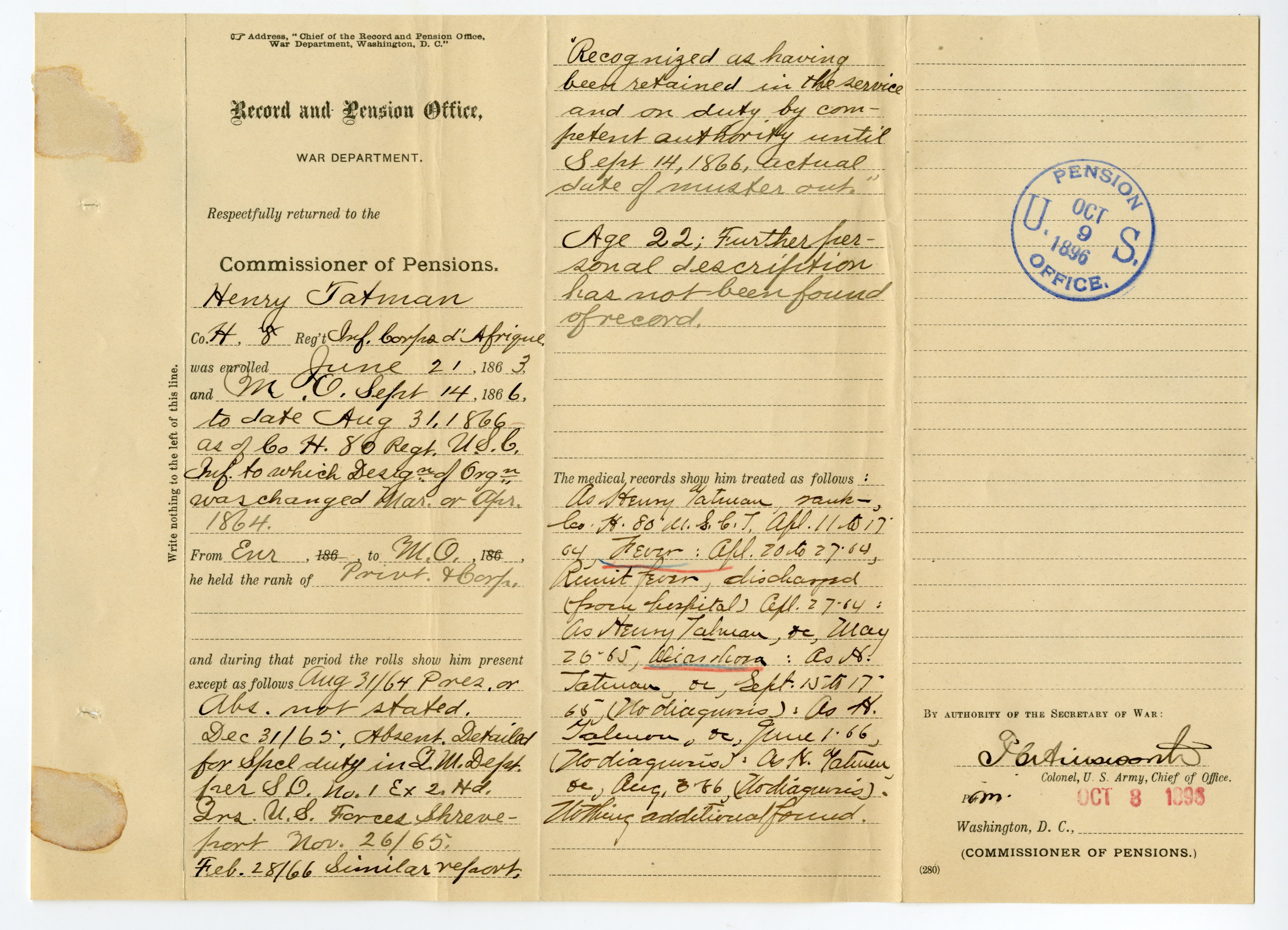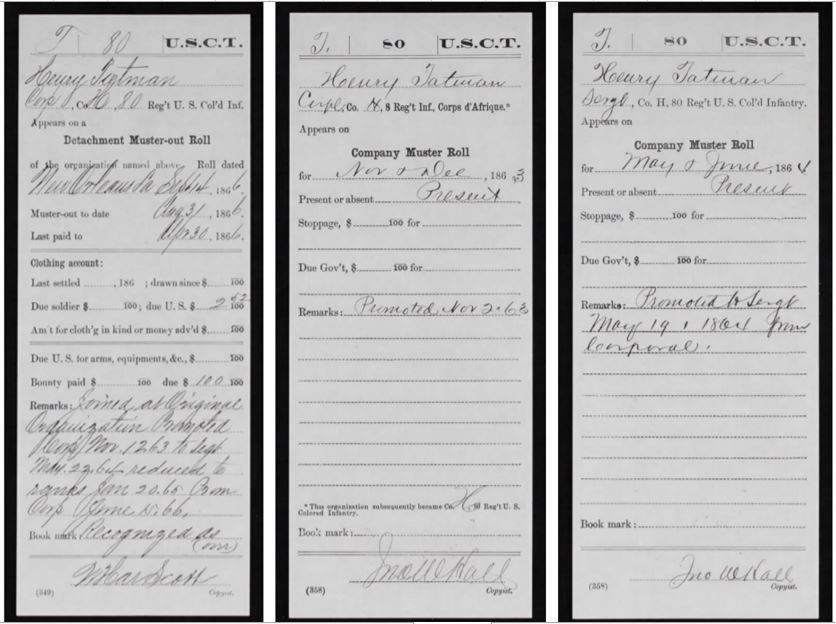
I received Henry’s pension file and it helped answer my most burning questions: how did Henry King end up in the Union Army? Did he run away from slavery? If so, how did he manage to escape? [See part 1 Finding Kin in the Civil War – Henry KING aka Henry Tatman (part 1).]
As a genealogist, my explorations include researching my African-descent ancestors from before the Civil War. Some of these ancestors were enslaved, but a large portion of my family were free. Doing slave research can be emotional, especially when you have a blood connection to the persons who are enslaved. There’s a sorrow that touches your spirit seeing your family in slavery documentation.
It meant a lot to read the pension file and learn that Henry had, in fact, run away from the Tatman plantation during the Civil War. A copy of Isabella King’s Widow’s Declaration, included in the pension file, states “that her husband was a slave and was ‘so said’ married to another slave ‘Matilda,’ who died about 1864.” Cyrus Tatman (the son of Henry’s last enslaver) corroborates this in one of his own affidavits: “…we know he was married the first time to a woman by the name of Mathilda Jason, who left Opelousas with Henry Tatman at the time the Federal army passed through here about December 1863, and they went to Berwick’s Bay, La., with the army.”
Recently a reader of this blog, Jessamy, contacted me about a book she had just inherited with information about my family. (Thanks Jessamy!) Coincidently, the snapshot of what she shared is relevant to this story. Spanning Three Centuries 1898 Onward, was written by Martha Alma Adelaide Tatman Hudspeth, Jessamy’s great-grandmother. Hudspeth is the granddaughter of Cornelius Duchane Tatman (Cyrus Tatman’s father) and Hester Griffith.
“Grandpa’s slaves were treated fairly and they behaved well. They were worth a fortune, which was all lost after the Civil War when the slaves were freed. Some of the slaves chose to stay and continue working as free men. There was old Aunt Tempie and her husband, Warren. Their children were Henry, Bob, Lewis, Frank, Martin, and Martha. Other slaves were Phyllis, Winnie, Phoebe, and Stella. All stayed until long after they were freed, except Henry. He ran away to the Yankees. Frank died.”
Note: Phyllis, Winnie, Phoebe, and Stella were also the children of Tempie[y] and Warren. Phoebe and Stella are living in Henry’s and Isabella’s household on the 1870 US Census.

Henry Tatman—now known as Henry King—was sworn in on June 21, 1863 as a private in Company H, 80th Regiment Corps d’Afrique of the United States Colored Troops (USCT) Infantry. Henry’s official muster in was 1 September 1863 at Port Hudson, Louisiana. Henry was promoted from Private to Corporal on 2 November 1863 and up to Sergeant, 22 May 1864. His rank was reduced down to Private on 20 January 1865. He was promoted, once again, to Corporal on 15 June 1866. His muster-out date was effective 31 August, 1866, in New Orleans, Louisiana. During his service, his medical records show that he also was admitted in the hospital several times, including to treat him for fever. Below, you will find his military service summary. Also, from Fold3 I’ve posted some of the details on his rank movements.



The file is combination of both Henry Tatman’s invalid pension application and Isabella’s widow’s pension file. On August 12th, 1890, Henry submitted an invalid pension and over the next two years, multiple documentation supporting his application. Henry said he suffered with rheumatism making him unable to do manual work. However, the doctor observed that Henry had “no chronic Rheumatism” and therefore was ineligible for a pension.
Henry’s pension application was rejected 20 January 1892 and he died February 25th, 1896. Henry never received his pension. In his affidavit for Henry, the doctor may have accidentally foretold Henry death. In his note, Henry’s doctor dismissively observes that “… in our opinion, [Henry is] entitled to a 4/18 rating for the disability caused by Piles [hemorrhoids].” Henry died from chronic diarrhea, a known symptom of Piles.
Later that year, after Henry’s death, Isabella applied for her widow’s pension. From September 1896 through to the end of 1897, numerous reports were submitted in support of Isabella’s widow’s pension application. On January 22, 1898, Isabella’s petition was finally approved with a monthly payment of $8, effective September 1896. Isabella was dropped from the pension rosters on May 3, 1906, after her death in February of that year.
There’s a healing that comes about when you view manumission documents or see that an enslaved person successfully ran away. I enjoyed learning more about Henry.
Happy searching!



Wow Cousin, this is a good read and I am so happy for you! Congratulations on your wonderful find!
LikeLiked by 1 person
Thanks Cousin for stopping by! I’m glad you enjoyed this post. I wasn’t to sure if it would work.
LikeLike